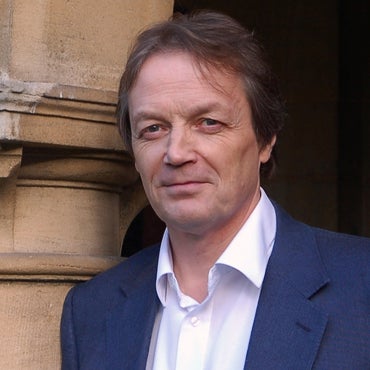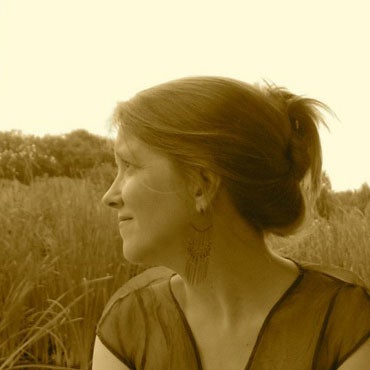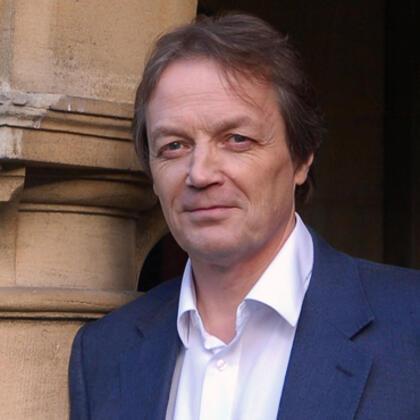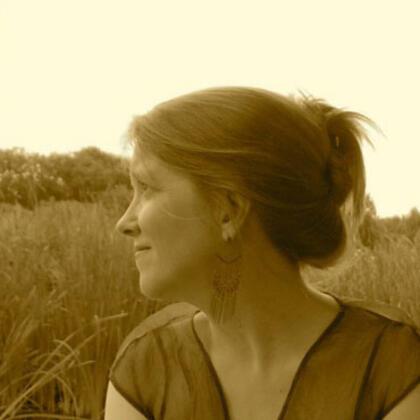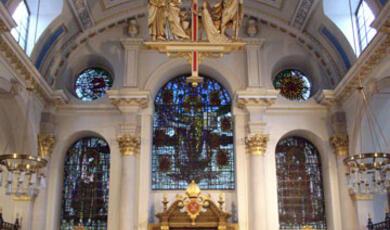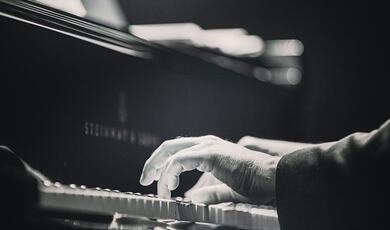Medieval Music: The Mystery of Women
Share
- Details
- Transcript
- Audio
- Downloads
- Extra Reading
During the last thirty years, the name of Hildegard of Bingen (d. 1179) composer, abbess and naturalist, has been gradually rescued from obscurity, notably by recordings of her works. The lecture will provide an opportunity to hear some of Hildegard’s most impressive compositions but also to explore more widely the phenomenon of the medieval female composer. For while Hildegard was unique, she was not alone; the richness of the musical remains she has left eclipse every competitor, and yet there were many other female mystics who created rhapsodic spiritual song whose works have not survived. Many of them are little known, but here they will step into the light.
Download Transcript
18 February 2016
Medieval Music:
The Mystery of Women
Professor Christopher Page
I would like to begin far from any place that I have named in these lectures so far, and indeed far from the Middle Ages. I set you down in the period that historians are now accustomed to call Late Antiquity. To be precise, we find ourselves in a landscape of ruins in Tunisia, once the great port of Carthage. A figure walks the streets of the city; dressed in the garb of a philosopher he is one of the earliest, perhaps the earliest, of the thinkers trying to refine the theology of Christianity, still a relatively new faith, in the language of Latin. This man is Tertullian and most of his writings cluster in the decades around 200. His book De anima, composed in 206-7 AD, contains a striking report. At one point in this characteristically dense treatise on the soul, Tertullian turns to the recent experience of prophets and visionaries, especially liable to be women, who have been granted insight into mysteries while in an intense spiritual state. A woman of Carthage, Tertullian tells us, recently had a visionary experience during the Sunday service. It seems that the woman in question was often favoured with 'such gifts of revelation'; she conversed with angels, even with Christ himself, during states of ecstasy that came upon her during communal worship. The material for these visions, Tertullian explains, came directly from the readings and chants of the Sunday mass:
There is among us today a sister favoured with the gifts of revelation that she experiences through an ecstasy of the spirit during the Sunday liturgy. She converses with angels, sometimes even with the Lord; she sees and hears mysteries, reads some peoples' hearts and applies remedies to those who need them. The material for her visions is supplied as the scriptures are read, psalms are sung, the homily delivered and prayers offered.
This is the earliest Christian text I know which acknowledges a special kinship between music, women and spiritual ecstasy. Much of what Tertullian reports must descend from the woman herself, notably the conversations with Christ, which I take it nobody overheard, or not both sides of the exchange. She claimed a great deal, in other words, all of which Tertullian seems to accept and to regard as a very welcome display of the power of the Holy Spirit. Nonetheless, it is easy to imagine how others might have taken a much more skeptical view. Tertullian's account reflects a view of women that is in a sense celebratory, acknowledging special gifts of the spirit, but ecstasy can be dangerously close to the hysteria and the irrationality that men, with patent injustice, have believed for much of Western history to be essentially female weaknesses. Women, on this understanding, are prone to abnormally intense experiences of the spirit because their very gender is a departure from a normative masculinity viewed as deliberative and rational. Male and intellectual.
I will return to this association between women, music and rapture, for it is one of the most powerful strains in the medieval perception of what was truly significant about women in their relationship to music and imagination. Yet any attempt to recuperate the contribution of women to musical life in the Middle Ages would certainly need a wider reach than the domain of the spirit. Indeed, it has always seemed to me that some of the materials relating to women's engagement with secular music are the more remarkable. Let me give you an example as we advance gradually towards the central middle ages. Once again, I am in story telling mode, as you will find me often this afternoon. Now we are in the sixth century, in Western France. Night has fallen, and the noise outside the convent of the Holy Cross in Poitiers has become so loud that the nuns inside can ignore it no longer. The people of the city, dwellers in the fortified shell of an old Roman town, are dancing to songs and the music of stringed instruments, presumably in the outlying fields beyond the walls. Inside the convent is Queen Radegund, the founder of the house, at prayer with two of her nuns. Suddenly, one of the nuns ceases her devotions, and blithely announces that she recognises one of the songs she herself composed just at that moment being sung by the townspeople as they dance. Radegund, who was as surprised as you may be by that remark, replies that this is 'very well' if it pleased the nun to hear 'the odour of devotion mixed with the odour of the world' in this way. The nun, ignoring Radegund's irony and defending herself with a determination, as if to make it all worse, replies that she remembers hearing two or three of her own songs during the course of the evening.
What were these songs? They were presumably in the common speech of the people, that is to say in a form of Latin rapidly evolving towards French for which there was, as yet, no dedicated system of spelling and no name, unless it be lingua romana. Our composer-nun was almost certainly of aristocratic background, for the nuns around a royal abbess usually were; did it often happen that women from noble Frankish families composed songs that townsmen and women might learn? We do not have the texts of the nun's songs, or at least we cannot identify them among the poems, spelled as Latin, that survive from sixth-century Gaul. We do, however, have the texts and music of some famous liturgical hymns that Radegund's biographer, Venantius Fortunatus, wrote to commemorate the reception of the relic of the Holy Cross in her convent. There may just be a distant echo here of the nun's lost songs, especially if the hymn is treated to the kind of rhythmic performance I have asked Emily to give:
Pange lingua
What of nuns at their true task, performing chant in the liturgy of mass and hours? Let us advance two more centuries – now we reach the eighth – where we find the Frankish Mayor of the Palace, Pippin, writing to Pope Zacharias on precisely that subject. (Pippin was not as obscure a figure as he sounds, by the way, since he was the father of Charlemagne, and was in many ways the founder of that great emperor's fortune). Amongst other matters of ecclesiastical discipline, Pippin asked the pope whether nuns were 'permitted to read the lessons publicly at Mass or on Holy Saturday and to chant either Alleluia or the Response'. The news that nuns were chanting the Alleluia or the Response at 'public' services in Frankish nunneries, services that were open to the local people, probably came as a shock to Pope Zacharias, who replied with a stern reproach with echoes of St. Paul: 'It is forbidden for women to minister at holy altars or to presume to perform any of those offices which men are required to discharge'.
We proceed two centuries more for an event that took place in the monastery of St. Gall, south of Lake Constance, early in the tenth century, which the monks regarded as a miracle. During the Lenten season, sometime not long before the year 926, a woman named Wiborada arrived at the monastery to visit her brother Hitto. They belonged to a good Alemannic family and both of them had a claim upon the hospitality of the monks of St. Gall. Hitto was a priest and a member of the secular clergy, currently teaching in one of the monastery schools, and Wiborada had spent many years in seclusion near the monastery of St. Gall. You will notice the contrast: the man is formally educated, the woman cloistered. One Saturday, Hitto was planning to celebrate a private mass at one of the side altars in the monastery, but there was nobody skilled in plainsong to assist him. With this in mind, he admitted to Wiborada that he was 'anxious about the next day's service, and especially concerning the chant that is called Tract', a soloist's chant, 'because he had no scholar, and no colleague skilled in chant, to help'. Next morning, Wiborada stood near the altar where Hitto was about to celebrate. The moment for the Tract arrived, and (I quote):
…without delay, Wiborada began to sing it with as much accomplishment as authority, so that neither in the order of the verses, nor in the accentuation of the words, nor in the modal character of the music, did she seem inferior to a priest.
The narrator of this story, Ekkehard I of St. Gall, writes for his fellow monks who live the liturgy every day, so he has no need to specify the chant that Wiborada sang. The modern reader therefore misses the very detail that makes Wiborada's performance a 'wonder'. The Tract for the first Sunday in Lent is Qui habitat, one of the longest and most elaborate compositions in the entire repertoire of Gregorian chant. There is no reference in the narrative to Wiborada singing from a book, so she must have learned it by heart; years of listening to Mass and Office had filled her memory with the plainsongs assigned to the cantor. This may record a moment of divinely inspired ecstasy, or sudden rapturous outpouring, but the episode also shows a woman whose mind was better stocked with chant than her brother, who finally snatched at her chance to break a long-enforced silence. O Lord, open thou my lips!
Two centuries further on – we are now in the twelfth – and we really hit our stride. A woman, now some eighty years of age, is writing to the clergy of Mainz in Germany to defend her actions in allowing an excommunicated nobleman to be buried in consecrated ground in her abbey. As a result of her decision, the house has been placed under an interdict and the nuns compelled to recite, not to sing, the liturgy. This is what she says in her complaint to the clergy.
…and I heard a voice proceeding from the living light concerning the various kinds of praise that David speaks of in a psalm: 'Praise him in the sound of the trumpet, praise him on the psaltery and harp', and so on up to this: 'Let every spirit praise the Lord'…When we ponder these things carefully, we remember how mankind needed the voice of the living spirit, which Adam lost through his disobedience; before his transgression, as yet innocent, he spent no little time joining his voice in company with the voices of angelic praises, voices that the spiritual nature of angels does encompass, called spirit from that Spirit which is God.
It is a thousand years since we were in Carthage where a woman was sent into a prophetic ecstasy by chant, hearing divine voices, and we meet something very like it here: '…and I heard a voice proceeding from the living light'. The writer here is also claiming a good deal for herself, like her distant predecessor known to Tertullian. Her tone is one of exhortation, almost of command.
Perhaps you recognize the writer, for in recent years many books and commercial recordings have made her even more famous now than she was in her own day. It is abbess Hildegard of Bingen. I have been involved with her music, on and off, for many years, and I remain unshaken in my conviction that she was one of the most extraordinary creative personalities of the Middle Ages. Hildegard came from a noble family in northern Germany and died in 1179, leaving behind many writings and many Latin chants, with a distinct musical voice, which rank as the earliest known compositions by a woman in the Western tradition.
I would now like you to hear a chant by Hildegard. She composed O ignis spiritus in honour of her own muse, the Holy Ghost: the Pentecostal tongues of fire which she (and her contemporaries) believed had descended upon her to teach her the mysteries of the faith. You can see Hildegard receiving this gift on the first page of the handout, taken from a manuscripts of her works, and on the next page the beginning of the original notation of the chant you are about to hear. Beyond that, you have the text and a translation. This is a large and rhapsodic composition, an ecstatic apostrophe (O fire of the Spirit…O breath of holiness…O fire of love…O purest fountain). The lines are rich in some of the traditional materials of Christian imagery of the Middle Ages (the spiritual lorica, or breastplate, for example), the sweet odours of spices from the Song of Songs, but all compounded with an exuberant energy that is pure Hildegard:
Hildegard of Bingen: O ignis spiritus
That chant is very characteristic of Hildegard in the sense that it would be almost impossible, I imagine, to make it sound like any part of a liturgical routine. There is something almost unsettling about the authority and urgency of that very individual musical voice which rises to contemplate with ecstasy, but also with dread, the face of God. I mean that there is rapture in the music, certainly, but also what a much later poet, Gerard Manley Hopkins, called being 'trod hard down with a horror of height'. I also mean that it is the musical voice of an autodidact and in that sense (let me be careful here) of a woman. Hildegard certainly received an education – we know that she was entrusted to the care of a woman named Jutta – and yet these two females were not as abundantly fed with the standard mental and spiritual food as the males of their day. In Hildegard's case, her hunger found nourishment in vision and fervent celebration, not in conventional forms of exposition or argument. The imagery of the poetry, as you saw a moment ago, is very dense; certainly it draws upon the bible and biblical commentary, but it is also highly personal; we do not have to read very far in Hildegard's verse to find the recurrent images in which the pressure of her imagination finds a measure of release. She is especially fond, for example, of evoking an aromatic tree, perhaps the cedar of Lebanon, that in her imagination slowly secreted (or as Hildegard more frankly says, that 'sweatd') a fragrant balm or something like Othello's 'medicinal gum'. There was an example in the chant we heard just now: terra viriditatem sudat; I translated that as 'the earth exudes freshness', but it literally means 'the earth sweats a greenness….'.
There is no doubt that Hildegard, in her letters, plays upon her femininity, complying with the ancient notion that women are inherently weak in body but may be (in exceptional circumstances) correspondingly strong in spirit. (There are signs, incidentally, that Hildegard was indeed prone to some form of pathology, though we remain uncertain what it was: a common suggestion is chronic migraine). Thus in 1153 we find Hildegard writing to Pope Anastasius saying that God, 'who is great without a failing, has now touched a poor little dwelling', meaning of course herself. Hildegard is not the only person of the Middle Ages who is reported to have learned the inner sense of scripture, or the skill of musical composition, as the apostles at Pentecost learned all the languages necessary for their ministry when the fire of the Holy Ghost settled upon them. The difference is that Hildegard claimed it for herself and that we have a great deal of the results in the form of her various treatises on nature and medicine, her theological writing and of course her music, which she collected and gave the characteristically exuberant and un-self-effacing title the Symphony of the Harmony of Celestial Revelations. Men found it easier, not harder, to believe in her exceptional spiritual gifts because she was a woman.
Hildegard had a no wish to conceal any of this. I quote her:
By visionary means I understood the writings of the prophets, of the evangelists, of the saints and of other sages without any human teaching, and expounded some of them, though I scarcely had any learning, just as an uneducated woman had taught me. I also composed and sang chant, with music, in praise of God and the saints without the instruction of any man for I have never studied either melody or chant.
What was the 'melody or chant' that she composed actually for? It has often been assumed that Hildegard composed her chants for the liturgy of her house, and perhaps she did; but I have always been drawn to a passage in the dossier that was prepared, and ready by the year 1233, to make a case for her canonization. (It was unsuccessful). One of the witnesses consulted for the document was a certain woman named Hedewigis, who said, and I quote:
the blessed Hildegard was continually on her sickbed through the lash of God, save when she was illuminated by the Holy Spirit and when she sang the sequence that begins thus, O virga ac diadema, at the prompting of the Holy Spirit as she walked around the cloister.
So there we have a glimpse, based on an eye-witness report, of Hildegard's music in use; it is not exactly a performance, indeed it is not really a performance at all, but a private devotion as she paces around the cloister of her nunnery singing her own chant.
Let us her that distinctive voice again. This is one of Hildegard's hymns to the virgin Mary: O viridissima virga. Here the biblical image of the Virgin as the rod or virga that shall come out of the loins of Jesse inspires Hildegard to revel in her imagery of perfumes and aromatic trees: 'When the time came that you flowered in your branches, there was 'Hail, Hail' to you, because the heat of the sun has exuded from you like the aroma of balm'.
O viridissima virga
Hildegard was in many ways unique, which partly explains the modern interest in her, but there were other women whom we might almost call hidden Hildegards. Consider, for example, Marie of Oignies, who died in 1213. Marie spent most of her life, with her husband, serving a leper hospital near Nivelles, and subsequently lived in a cell attached to the conventual church of Oignies. The contemporary biography of her, by Jacques de Vitry, gives an extraordinary account of a song she sang and apparently composed during her last illness: I say 'extraordinary' for the performance lasted a total of three days. It seems to have comprised a set of antiphon-like songs, with texts in French. Here is an extract from the passage in which Jacques de Vitry describes it:
Now the promised time was approaching that she had anticipated with many tears, and prayed for with groans and sighs. Behold! There was suddenly a sound, and 'the voice of the turtle was heard in our land' [Song of Songs, 2.12], a voice of exultation and of witness as if it were the sound of one feasting and rejoicing, as if it were God on high. God wiped away every tear from the eyes of his handmaiden, filling her heart with joy and her lips with music. She began to sing with a loud and clear voice, and did not cease to praise God for the space of three days and nights. She gave thanks, and sang the sweetest song about God, the holy angels, the blessed virgin, other saints, her friends, the Holy Scriptures, weaving it together in a syllable-counting poetry with sweet music. She did not pause to devise her meaning, nor delay to put it into verse, but God gave it to her at that very moment as if it had all been written down before. Rejoicing with a continuous cry she did not labour over her thoughts nor interrupt the song to shape the music. It seemed to her that one of the Seraphim had spread his wings over her breast, and with his sweet help and ministrations her song was inspired without any difficulty.
Is this not very reminiscent, in some respects, of what happened at Carthage long before? Here is the same emphasis upon spontaneous, divinely-inspired and rapturous utterance: 'She did not pause to devise her meaning… It seemed to her that one of the Seraphim had spread his wings over her breast'. Here also, as with Hildegard, is the theme of knowledge divinely acquired since it was not available to a woman, save in pieces, through the normal educational means of school and university available to men. 'She put forth many subtle things', says Jacques de Vitry, 'that she had never been formally taught'.
The story of Marie of Oignies and her three-day song is is only one of the various documents that reveal the women I am calling hidden Hildegards. More striking still, perhaps, was Christina Mirabilis, or Christina of Sint-Truiden, today in eastern Belgium, who died in 1224. At one stage, her biographer reports, she lived in trees 'like birds of the air', and while staying with the nuns of a certain house, not far from Sint Truiden, Christine's body suddenly began to whirl around 'so that the individual limbs of her body could not be distinguished'. Then Music emanated from her body as if from a spinning top:
Then a certain wondrous harmony sounded between her throat and her chest, which no mortal could either understand or imitate with any kind of artifice. Her melody had the flexibility and modal organization of music alone; the words of the melody, so to speak, if words they may be called, rang forth but were unintelligible. No breath or vocal sound came through her mouth or nose meanwhile, but only the harmony of an angelic voice between her chest and her throat.
Another passage in Christine's biography describes her singing while resident in yet another house of nuns:
While in this same place, Christine attended Matins every night; when everyone else had left them church, and the doors were locked, she walked on the open space of the church pavement and sang a chant of such sweetness that it rather seemed an angelic song than human. It was so wondrous to hear that it eclipsed all musical instruments and all mortal voices, yet it was far from equal in sweetness to that harmonious and incomparable sound which resonated between her throat and her breast when her mind was disengaged. This song, I say, was in Latin, adorned with wondrous musical phrases.
Here a woman's body seems to become an instrument for a music whose effect was evidently extraordinary, and which the biographer, struggling to describe it, calls 'a harmonious and incomparable sound which resonated between her throat and her breast when her mind was disengaged'. If Christine's mind was indeed inactive, and her mouth closed, then there were no words and no singing in the customary sense. The sound passed beyond mere words, even perhaps beyond voice, to something else. Christine has become as sonorous as one of the great ceramic jars inserted high up into the walls of medieval churches and abbeys to catch the sound of chanting and return a resonance. She has become a vessel, but is so far from being a 'weaker vessel' that her biographer, who is of course a man, can only gaze in wonder.
I have mentioned some exceptional women, and therefore in a sense I have missed the heart of my subject. The civilisation of the Middle Ages rested on the backs of women as surely (and you will forgive the comparison) as it rested on the backs of sheep through the medium of parchment. Where did all those bishops, abbots and masters of theology take the very first steps in their education? With a priest, a monk or some other male master? Yes, but the really foundational work was done earlier than that. A twelfth century count of Arnstein, in Germany, learned his letters with a nurse; an archbishop of Armagh who died in 1148 was taught in early childhood by his magister et mater: 'his teacher and his mother'. The work of such women, the makers of human capital day by day, year by year, remains mostly unrecorded. So here, to sing for all of them, is Hildegard one last time, hymning in her most rhapsodic manner in honour of the patron saint of her abbey, St. Rupert. He is here presented as a part of the heavenly Jerusalem as described in the Book of Revelation; that city, you will recall, is made of gems and precious stones, one of which is Hildegard's patron: 'For you, O noble Rupert, shimmer in these like a jewel. You cannot be hidden by human foolishness, just as a mountain cannot be hidden by a valley'.
O Jerusalem
© Professor Christopher Page, 2016
This event was on Thu, 18 Feb 2016
Support Gresham
Gresham College has offered an outstanding education to the public free of charge for over 400 years. Today, Gresham plays an important role in fostering a love of learning and a greater understanding of ourselves and the world around us. Your donation will help to widen our reach and to broaden our audience, allowing more people to benefit from a high-quality education from some of the brightest minds.


 Login
Login
